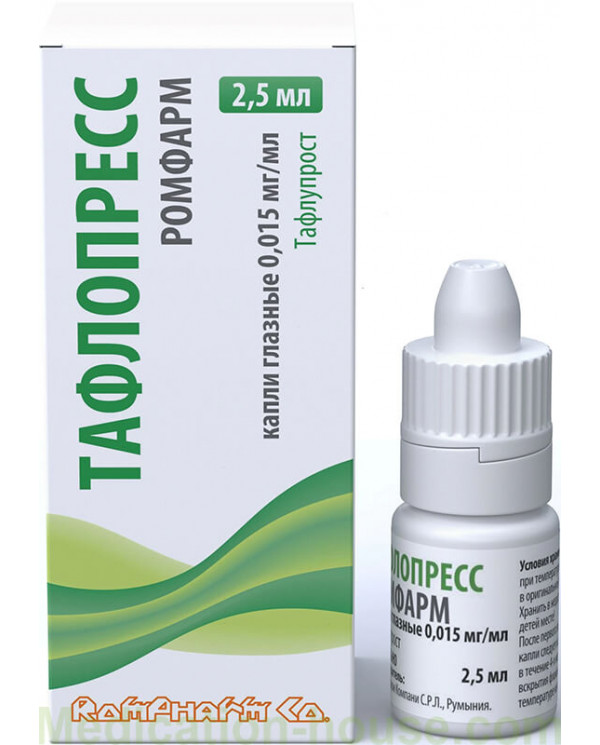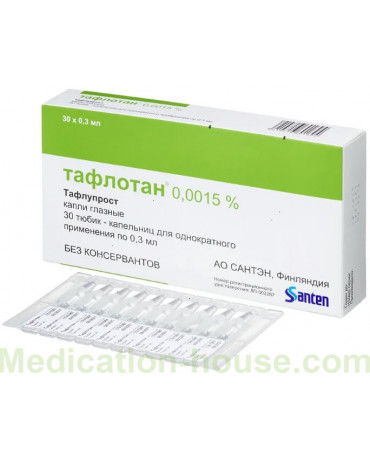Taflopress user manual
You can buy Taflopress here
Indications for use
Increased intraocular pressure in patients with open-angle glaucoma and ophthalmic hypertension:
as monotherapy in patients with insufficient response to first-line drugs or in the presence of intolerance to first-line drugs or contraindications to these drugs;
as an adjunct therapy to beta-blockers.
Active ingredient, group
Tafluprost, antiglaucoma agent - prostaglandin F2-alpha synthetic analogue
Contraindications
Hypersensitivity to the active substance tafluprost or to any of the excipients of the drug.
Age up to 18 years (no data on clinical use).
Carefully
Taflopress should be used with caution in patients with aphakia, pseudophakia with rupture of the posterior lens capsule or with anterior chamber intraocular lenses, as well as in patients with established risk factors for the development of cystoid macular edema or iritis / uveitis.
Taflopress should be used with caution in patients with aphakia and pigmentary or pseudoexfoliative glaucoma.
Taflopress should be used with caution in patients with neovascular, closed-angle, narrow-angle, or congenital glaucoma.
Taflopress should be used with caution in patients with severe bronchial asthma, in patients with impaired renal / hepatic function.
How to use: dosage and course of treatment
The recommended dose is one drop of Taflopress Rompharm into the conjunctival sac of the affected eye once a day, in the evening. The dose must be instilled strictly once a day, since more frequent use can reduce the effect of lowering IOP.
A short-term nasolacrimal occlusion or gentle closure of the eyelids after instillation of the drug is recommended.
Pharmachologic effect
Taflopress Rompharm is an antiglaucoma agent - prostaglandin F2-alpha synthetic analogue.
Reduces intraocular pressure (IOP) by increasing the uveoscleral outflow of aqueous humor.
Side effects
From the nervous system
Often: headache.
On the part of the organ of vision
Often: itchy eyes, eye irritation, eye pain, redness of the eyes / conjunctiva, changes in eyelashes (increase in length, thickness and number of eyelashes), dry eyes, discoloration of eyelashes, foreign body sensation in the eyes, erythema of the eyelids, superficial punctate keratitis (PTC ), blurred vision, increased lacrimation, decreased visual acuity, photophobia, and increased pigmentation of the iris.
Uncommon: asthenopia, conjunctival edema, blepharitis, cellular opalescence of moisture in the anterior chamber of the eye, conjunctival follicles, allergic conjunctivitis, an inflammatory reaction in the moisture of the anterior chamber of the eye, pigmentation of the conjunctiva, a feeling of discomfort in the eyes, eyelid pigmentation, eyelid edema, eyelid swelling in the eye.
Frequency unknown (cannot be estimated from the available data): iritis / uveitis, worsening of the eyelid fold, macular retinal edema / cystic macular edema. Very rare cases of corneal calcification have been reported in association with the use of phosphate-containing eye drops in some patients with significant corneal lesions.
From the respiratory system, chest and mediastinal organs
Frequency unknown: exacerbation of bronchial asthma, shortness of breath.
From the skin and subcutaneous tissues
Uncommon: hypertrichosis of the eyelids.
Special instructions
Short-term blurred vision may occur, therefore, it is necessary to refrain from driving and performing activities that require increased concentration of attention and speed of psychomotor reactions until vision is restored.
Before starting treatment, patients should be informed about the possibility of eyelash growth, darkening of the eyelid skin and increased iris pigmentation. Some of these changes may be permanent and can lead to differences between the eyes if the drug is instilled in only one eye.
Taflopress should be used with caution in patients with aphakia, pseudophakia with rupture of the posterior lens capsule or with anterior chamber intraocular lenses, as well as in patients with established risk factors for the development of cystoid macular edema or iritis / uveitis.
There is a possibility of hair growth in areas where tafluprost solution is in constant contact with the skin surface.
Application during pregnancy and lactation
Contraindicated. May have adverse effects on pregnancy and on the fetus / newborn (infant).
Interaction
When using several ophthalmic drugs, the intervals between their use should be at least 5 minutes.
Storage conditions
At temperatures from 2 to 8 ° C.
After opening the bottle, store in a dark place at a temperature not exceeding 25 ° C.
Keep out of the reach of children.
The shelf life is 3 years. From the moment of opening the bottle - 28 days!
Do not use after the expiration date.
Terms of sell
You don't need a prescription to buy Taflopress.


